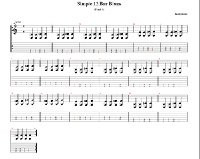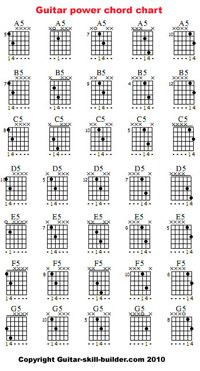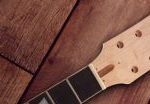Learning guitar can be incredibly rewarding, and one of the first steps in your musical journey is mastering basic guitar chords. A Basic Guitar Chord Chart For Beginners is an invaluable tool to help you visualize and learn these essential shapes. While a chord chart itself is a fantastic starting point, understanding how to use it effectively and incorporate chords into simple songs is key to your progress.
In this guide, we’ll provide you with a free, printable guitar chord chart and explore how to use it to learn your first chords and start playing simple songs. We’ll also delve into easy chord progressions to get you making music right away. Whether you’re playing acoustic or electric guitar, these fundamental chords are the bedrock of countless songs.
Grab your guitar, and let’s dive in!
Free Printable Guitar Chord Chart: Download and Get Started
Below is your free basic guitar chord chart. You can right-click on the image to save it for easy access, or download the PDF version for a high-quality printable chart.
Downloadable guitar chord chart here.
This chart features what are often called “cowboy chords.” These are open chords, primarily played in the first few frets of the guitar, and they form the foundation for a vast number of songs across genres. From classic folk tunes to rock anthems, mastering these chords opens up a world of musical possibilities.
 Simple guitar chord chart for beginners
Simple guitar chord chart for beginners
Understanding Your Guitar Chord Chart
A guitar chord chart is a visual representation of the guitar fretboard, showing you where to place your fingers to play a specific chord. Let’s break down the elements of a typical chord chart:
- Vertical Lines: These represent the strings of your guitar. The leftmost line is the thickest string (low E string), and the rightmost line is the thinnest string (high E string).
- Horizontal Lines: These represent the frets of your guitar. The top line is the nut (the beginning of the fretboard), and the numbers to the left indicate the fret number.
- Dots: The dots on the chart indicate where you should place your fingers. Numbers within the dots (1, 2, 3, 4) often correspond to your fingers:
- 1: Index finger
- 2: Middle finger
- 3: Ring finger
- 4: Pinky finger
- “X” above a string: This means you should not play that string.
- “O” above a string: This means you should play that string open (without pressing down any frets).
Essential Basic Guitar Chords for Beginners
The basic guitar chord chart above focuses on the most fundamental chords for beginners. These commonly include:
- A Major (A)
- C Major (C)
- D Major (D)
- E Major (E)
- E minor (Em)
- F Major (F)
- G Major (G)
- A minor (Am)
- D minor (Dm)
These chords are often the first chords guitarists learn because they are relatively simple to finger and are used in countless popular songs. Mastering these chords is a crucial stepping stone in your guitar learning journey.
How to Use Your Basic Guitar Chord Chart Effectively
Learning chords isn’t just about memorizing shapes; it’s about developing muscle memory and training your fingers to move efficiently. Here’s a step-by-step approach to using your basic guitar chord chart:
- Start with One Chord: Choose one chord from the chart, for example, C Major.
- Finger Placement: Look at the chart and carefully place your fingers on the strings and frets as indicated. Ensure your fingertips are just behind the fret, pressing down firmly enough to get a clear sound without buzzing.
- Check for Clarity: Strum the chord slowly, string by string. Listen for any buzzing or muted strings. If you hear buzzing, adjust your finger positions slightly until each note rings out clearly.
- Practice Chord Transitions: Once you can play a chord cleanly, start practicing switching between two chords. For instance, practice moving between C Major and G Major. Focus on smooth and efficient transitions, minimizing pauses between chords.
- Slow and Steady Wins the Race: Begin slowly and focus on accuracy. Speed will come with practice. Relax your hand and arm to avoid tension, which can hinder your progress and cause fatigue.
- Build Calluses: If you’re a beginner, your fingertips might feel sore initially. This is normal! Keep practicing, and calluses will develop, making it more comfortable to play.
Simple Chord Progressions to Get You Playing Songs
Chords by themselves are like words; you need to combine them to create sentences, or in this case, songs! Chord progressions are sequences of chords that create a musical phrase or section. Here are some common and easy chord progressions using the basic guitar chords from your chart:
- C – G – Am – F
- G – D – Em – C
- D – A – Bm – G
Practice transitioning between the chords in these progressions. Use a metronome to keep a steady beat and gradually increase the tempo as you become more comfortable. Experiment with different strumming patterns to add rhythm and groove to your playing.
Tips for Effective Practice
- Consistency is Key: Short, regular practice sessions are more effective than infrequent long sessions. Aim for at least 15-30 minutes of practice most days of the week.
- Use a Metronome: A metronome helps you develop your timing and rhythm. Start slowly and gradually increase the tempo as you improve.
- Listen Actively: Pay attention to the sounds you’re producing. Listen for clarity, timing, and smooth chord changes.
- Be Patient: Learning guitar takes time and dedication. Don’t get discouraged if you don’t see results immediately. Celebrate small victories and keep practicing!
Expanding Your Chord Vocabulary
Once you’re comfortable with these basic guitar chords, you can start exploring other chord types and positions. Consider learning:
- Barre Chords: These chords allow you to play different chords up and down the neck and are essential for playing in various keys.
- Minor Chords and 7th Chords: Expanding your chord vocabulary with minor and 7th chords will add depth and complexity to your playing.
 Blues Guitar Chords
Blues Guitar Chords
 Guitar power chord chart page
Guitar power chord chart page
Conclusion: Your Guitar Journey Begins Now
A basic guitar chord chart for beginners is your starting point on an exciting musical adventure. By downloading your free chart, practicing regularly, and incorporating these chords into simple songs, you’ll be well on your way to playing the music you love. Remember to be patient, persistent, and enjoy the process. Happy playing!

